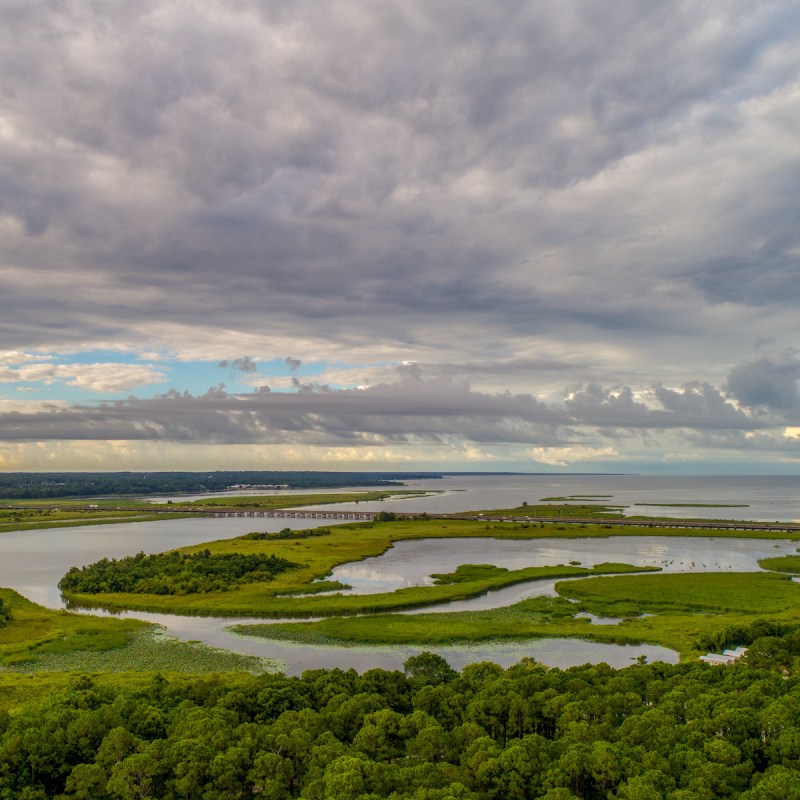
In 2014, a researcher with the University of Georgia released a paper titled, “Alabama’s Biodiversity is Remarkable” (linked below). In it, he described the state as being “the Fort Knox of the nation’s biodiversity.” It came as a shock to most of the country and the world, but those of us who explore Alabama’s beautiful countryside knew there was something special about the state for a long time.
Videos by TravelAwaits
Basically, high biodiversity means that an area supports an incredible variety of animals, plants, fungi, and even microorganisms, all working together to create an intricate web of life — an ecosystem. That sums up Alabama quite nicely. Its warm, humid climate combined with 132,000 miles of rivers, streams, and its 60 miles of shoreline along the Gulf of Mexico makes the state fertile ground for plants and wildlife.
The numbers are mind-blowing: 332 species of freshwater fish (first in the U.S.), 180 species of freshwater mussels (first in the U.S.), 27 species of freshwater turtles (first in the U.S.), over 3,100 native trees, plants, and shrubs. Well, you get the idea.
Here are the six of the best experiences you can have in one of the most biologically diverse states in America: Alabama.

1. Splinter Hill Bog — Bay Minette
The Ruth McClellan Abronski Splinter Hill Bog on Alabama’s Gulf Coast is called the “most visually impressive pitcher plant bog in the world.” Simply known as Splinter Hill Bog by locals, the bog literally overflows with thousands of white top pitcher plants between March and August, reaching their peak around June and July.
A pitcher plant is a carnivorous plant, much like a Venus flytrap, except they have a long tube. Insects are attracted to the plant by sweet nectar inside this tube. Once they climb or crawl in, tiny hairs that are bent downwards prevent them from escaping, and that nectar turns out to be their demise.
In addition to the white top pitcher plant, Splinter Hill — which is managed by the Nature Conservancy — plays host to four other species of pitchers and at least seven other documented carnivorous plants.
Pro Tip: You don’t have to hike far to see the spectacular show. A 0.1-mile ADA-accessible walkway leads to the main field of plants from the parking area. But there are plenty more plants and wildflowers to see at the bog along an easy walking 3.1-mile trail that winds through the preserve.

2. Mobile-Tensaw River Delta — Spanish Fort
The Mobile-Tensaw River Delta, the second-largest in the country behind the Mississippi, spans 200,000 acres and has rightfully earned the moniker, “America’s Amazon.” Here, five rivers converge to create an intricate web of bayous, swamps, river bottomland, and marshes that truly does resemble the Amazon’s rainforest environment.
Hidden deep in the mysterious backwaters are ancient Indian mounds where civilizations first took root there, military batteries built by Spanish armies to protect their claim on the land from the French in the 1700s, and the remains of the last slave ship to arrive in America, the Clotilda.
Beyond history, the delta is a wealth of natural beauty with acres of pitcher plants in its pine seepage bogs, towering cypress trees looming over the muddy water, fields of purple iris and seagrass waving in the breeze along the banks and in marshes, and where alligators, wild boar, and black bear roam freely while bald eagles, pelicans, and osprey soar high above.
There are a few ways to experience the delta. The first is an exhilarating ride via airboat, where a skiff is propelled for a fast ride along the waterways, then ducks into marshy areas and bayous that most boats can’t travel to.
Bring along a kayak or rent one from a local outfitter and paddle the backwaters of the delta on the Bartram Canoe Trail for an incredible close-up adventure with those alligators.
And for adventure without the effort, sign up for a ride on one of the tour boats like those at Wild Native or Historic Blakeley State Park, where experienced guides take you down the bayous and channels and tell you the history of the delta and point out points of interest.
Pro Tip: Paddling the delta is not for the neophyte paddler. Even though the Bartram Canoe Trail is blazed with signage, it is still easy to get turned around in a bayou. It’s best to go with experienced paddlers or a guide.

3. Alabama Birding Trail
Alabama is a birder’s paradise, with over 400 species being identified from Huntsville to Mobile, including many rare or endangered species and migratory birds. Just over 10 years ago, the Alabama Birding Trail was established and includes over 280 prime bird-watching locations across the state.
The trail is divided up into eight separate geologic regions, each offering a different and unique viewing experience. It may be a simple bench along the banks of a tranquil lake or pond to view waterfowl. Maybe it’s a stroll down an old logging road through beautiful swamps and wetlands to glimpse brown thrashers and brown-headed nuthatch. Or how about a walk along the gleaming white beaches of the Gulf of Mexico to view osprey, sandpipers, and snowy plovers?
Pro Tip: I highly recommend that you make plans to attend the annual Alabama Coastal Birdfest, which is held annually on the first weekend of October. Based at the Five Rivers Delta Resource Center in Spanish Fort, the 5-day event is packed wall-to-wall with presentations on everything from raptor demonstrations to “how-to” instruction and many guided tours to various locations including the Mobile-Tensaw River Delta mentioned earlier.

4. Cahaba Lilies — West Blocton
A beautiful flower that can only be found in Alabama, Georgia, and South Carolina is the Cahaba lily. A member of the spider lily family, the gorgeous Cahaba lily sports a brilliant white 3-inch wide flower. The lily can only be found in the swift currents of rocky river shoals where there is plenty of sunlight, which makes Alabama’s Cahaba River one of the few places you can view the plant.
The lilies bloom between mid-May to mid-June, generally from Mother’s Day to Father’s Day. The best place to view them is at the Cahaba River National Wildlife Refuge, which is located 5 miles east of West Blocton, Alabama, just off of County Road 24 on River Trace.
Pro Tip: The Cahaba River Society hosts the Cahaba Lily Festival on the last Saturday of May each year with music, hikes, presentations, and of course, views of the fabulous lily.

5. Keel Mountain Preserve — Gurley
The Nature Conservancy does an amazing job at protecting sensitive habitats and landscapes not only in Alabama but across the country. One of their sites in Alabama is the Keel Mountain Preserve.
Located only 16 miles southeast of Huntsville, the 310-acre preserve was purchased by the conservancy to protect the endangered Morefield’s leather flower. This vining plant produces beautiful large bell-shaped flowers around June, depending on the amount of rainfall. The vibrant purple bloom adds a splash of color to the otherwise dark greens of summer. The plant is only found in six places in the world, all of which are in the Huntsville area.
The centerpiece of the preserve is the beautiful and picturesque 100-foot cascade known as Lost Sink Falls that tumbles down a limestone bluff where it disappears underground into a 30-foot deep sinkhole.
Pro Tip: A rugged 2.2-mile (total), moderately difficult out-and-back hike over rock slabs and boulders leads you to the waterfall. The trail is easy to follow with green plastic diamond markers bearing yellow arrows and the Nature Conservancy logo leading the way.

6. Sauta Cave National Wildlife Refuge — Scottsboro
Located on the banks of a finger of Lake Guntersville, Sauta Cave has seen plenty of human activity over the years. It was a saltpeter mine during the Civil War, a speakeasy in the 1920s, and a fallout shelter in the 1960s. Today, the cave is known for its amazing aerial show.
The cave and the surrounding 264 acres were placed under federal protection in 1978 to preserve the endangered gray and Indiana bat population that lives there. The cave provides a warm and cozy environment for bats to breed in, what scientists call a “major maternity cave.”
It is estimated that over 400,000 bats call the cave home — that’s almost 40 percent of all of the gray bats in North America. Each year between July and August, just as the last rays of sunlight begin to dim and the sun sets below the horizon, the bats come alive and put on a spectacular aerial show that you will never forget.
At first, only a handful of bats flutter out of the entrance. Suddenly, the scene bursts with thousands of them, harmlessly swooping around the sky, sometimes only inches from your head, to scoop up their dinner of insects.
Pro Tips: Entrance to the preserve is free. There is a 100-yard universally accessible trail from the parking area on US Highway 72 that leads to a platform near the cave entrance. The cave is gated so people can’t access it. Wear a poncho with a hood or carry an umbrella to protect you from bat droppings, use insect repellent, and bring a flashlight for the walk back to the car after sunset but do not shine the light at the cave or the bats as they emerge.
